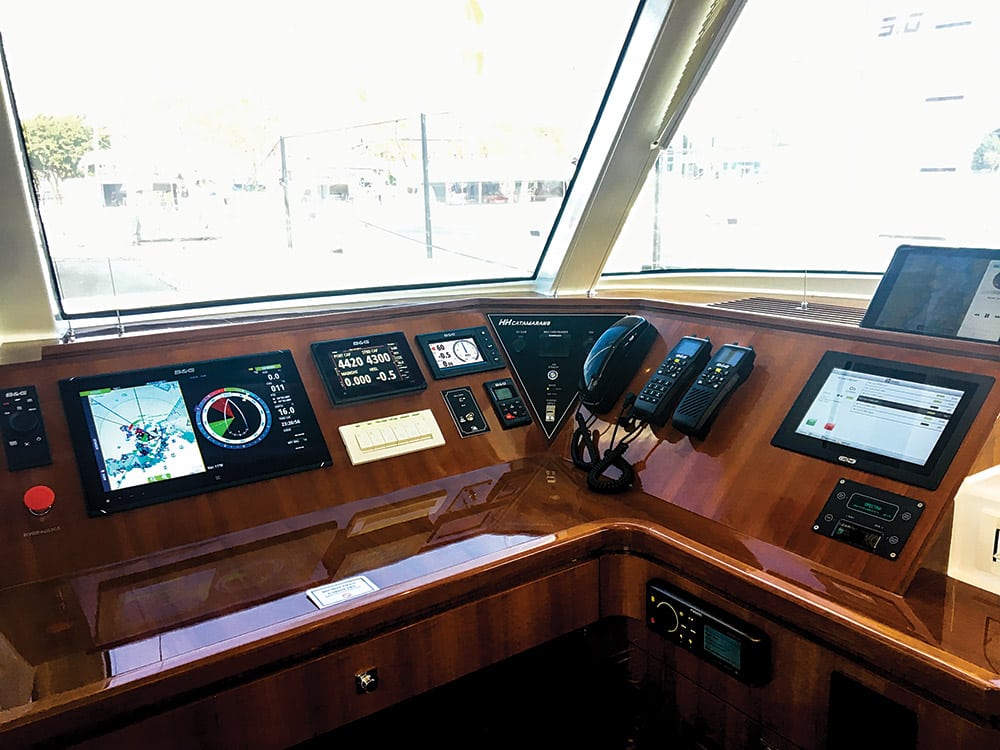
As a marine-electronics editor and new-boat reviewer, I’m careful to remain vigilantly brand agnostic. However, when it comes to classic plastics, I have an unapologetic favorite, namely Southern Cross, my dad’s modified J/44, which was built in 1990 and which my family has owned since 2001. Sure, she’s not thrilling on sub-6-knot days, but given breeze, she’s a pure joy to sail. While I’ll admit that part of my enchantment stems from the thousands of miles I’ve logged aboard her capable hull, the bulk of my infatuation is due to the fact that her designer, Rod Johnstone, nailed so many small but critical details (we’ll kindly overlook her less-than-ideal traveler placement), including great sight lines, comfortable cockpit ergonomics and easy access to instrument screens, buttons, engine controls and critical winches from her destroyer-style wheel. While some of Southern Cross’ electronics may no longer be state of the art, they have served our family well, and for me, a boating writer, she’s always been a solid baseline for evaluating cockpit and nav-station electronics installations aboard new boats.
Boat design and marine electronics have obviously evolved significantly since 1990, but the same design, installation and ergonomics challenges that Johnstone mastered are still relevant for contemporary designers, and in some cases, have been exacerbated by today’s dual helms and beamier transoms. With that in mind, I strolled the docks of the 2017 U.S. Sailboat Show in Annapolis, Maryland, to see how contemporary builders approach the complicated but critical process of determining where to install above- and belowdecks electronics and systems controls.
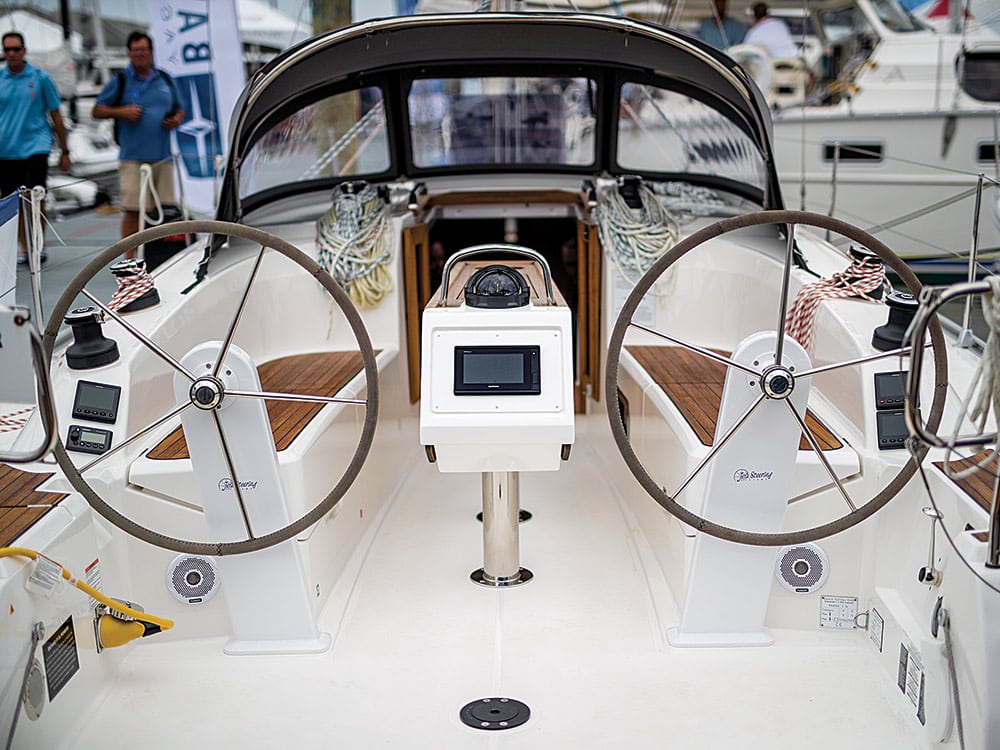
Sailboat construction starts with a carefully considered layout that typically begins on a computer screen. “We do all the preproduction design work in the computer,” says Hallberg-Rassy’s Magnus Rassy. He describes electronics installations as “a battle of tenths of inches” to incorporate all of the desired features. “We don’t use mock-ups. Through the years, we’ve built a table of know-how for different measurements, what works ideally, and the minimum and maximum requirement in different contexts. We can build several versions of a design on the computer before the real boat is produced, but once the decision is made, it’s rare that changes are required.”
Jeff Jorgensen, Jeanneau North America’s commercial product specialist, says Groupe Beneteau, the world’s largest boatbuilder and owner of the Jeanneau brand, uses highly specialized software called CATIA — also used by Boeing — for the initial design. However, unlike Hallberg-Rassy, the company creates prototypes before casting molds. “We build a to-scale model of each cockpit, and we get everyone who comes in — including the UPS guy — to sit there and check out the sight lines and the sheets,” he says. Once this feedback has been integrated into the design, Jeanneau builds a limited run. “We send the first three boats out to the boat shows and wait for feedback so that we can fine-tune the design if necessary.”
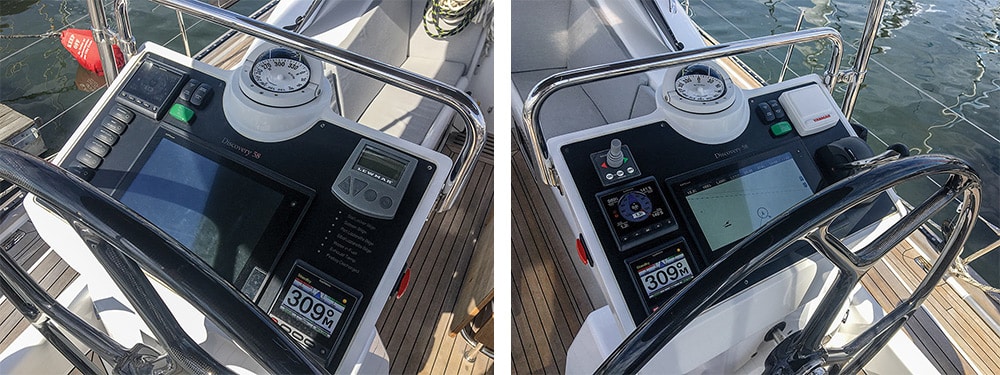
Once a new model is launched, the process becomes one of subtle refinement, says Rassy. “There’s a continuous development, based both on customer feedback and our own experience.” Rassy personally test-sails each new model and remains attuned to customers for their feedback. “For example, one boat owner managed to drop the anchor while sailing, so we understood we needed to have the anchoring button at the pedestal in a way that it cannot be activated by accident,” he says.
Twin helm stations is a design trend that has emerged in recent years and is now de rigueur in most product lines. As the beam of many sailboats has widened and been carried farther aft, the twin wheels open up a lane for passing through the cockpit to and from the transom, and they allow the skipper to sit well outboard with better sight lines, while eliminating the need for a single large-diameter wheel. From an electronics standpoint, though, this creates the potentially expensive scenario of needing two chart plotters, one at each steering station.
“The problem for us as a manufacturer is that it gets costly to repeat equipment,” says Jorgensen. “It’s the best way to go, but from the customer’s perspective, it can be a little hard paying for a second chart plotter.”
More traditional designs don’t have this problem. “With the single helm on the Gunfleet 43, we typically have a 12-inch plotter centered in the console, with the compass to one side and the engine/thruster controls, plus centerboard up/down buttons and position indicator, on the other,” says Robin Campbell, Gunfleet Marine’s sales director. “The engine gear lever and throttle is on the right-hand side of the pedestal column because most people are right-handed. These are the mission-critical items, so any other equipment is fitted around them to suit individual client choices.”
Gunfleet builds semi-custom yachts and has created a highly innovative helm design that features a prominent center console, which stands slightly aft of the wheel. The wheel itself wraps backward around the instruments, creating an installation that can easily be seen and touched from any helming position without having to reach through the wheel spokes. “Gunfleet pedestals, known as Flightdeck pedestals, were inspired and developed by Gunfleet in collaboration with the yacht’s designer, Tony Castro, and Lewmar Marine,” says Campbell. “We mold them in-house and fit them with Lewmar steering gear.”
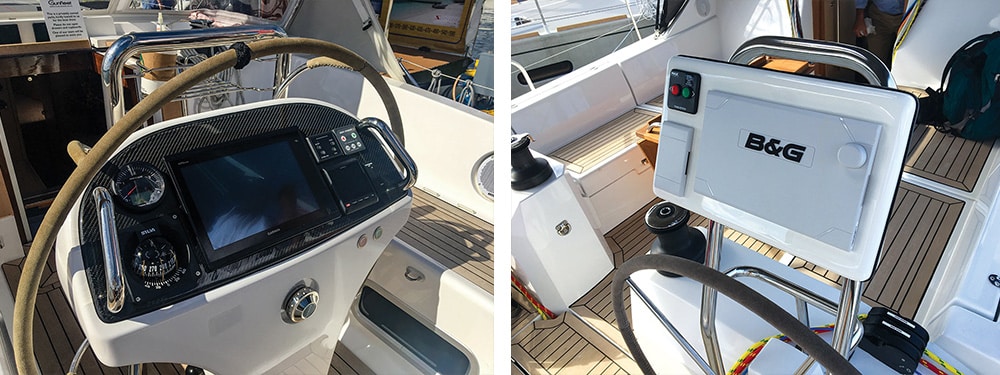
This installation is doubled on Gunfleet’s 58- and 74-foot offerings, with some modifications. “We made the port pedestal the maneuvering pedestal, with the engine’s start/stop buttons, thruster controls and autopilot main control, with the throttle again on the right-hand side of the column,” says Campbell. In a pinch, a skipper at the starboard helm can still reach across to the diesel controls. “The starboard pedestal, meanwhile, is the sailing pedestal and has the hydraulic in-mast furling control buttons for the mainsail, centerboard controls and indicator, a hydraulic cutoff button and compass.”
Some price-conscious builders employ waterproof instrument housings that can be fit on or under a cockpit table, for example, allowing a single chart plotter to service both helm positions. Alternatively, a standard installation might include a chart plotter at just one helm. While this saves money, it effectively means sailing without electronics while on one tack.
Irrespective of the number of chart plotters that a builder (or owner) decides on, an ergonomically efficient design and installation will allow users to avoid reaching their arms through the wheel spokes, which could quickly become a safety issue should the helmsman have to unexpectedly put the wheel over hard. Likewise, a good helm design allows users to easily see their screen(s) from a variety of positions and doesn’t block sight lines to sails or the horizon. Large binnacle-mounted pods, says Rassy, can be problematic on smaller (and even some larger) yachts thanks to the growing demand for ever-bigger display screens. Determining where to install nav equipment belowdecks is also a game of tenths of inches. However, this challenge is changing thanks to the advent of electronic cartography and Wi-Fi-enabled chart plotters that can be accessed by tablets and even smartphones.
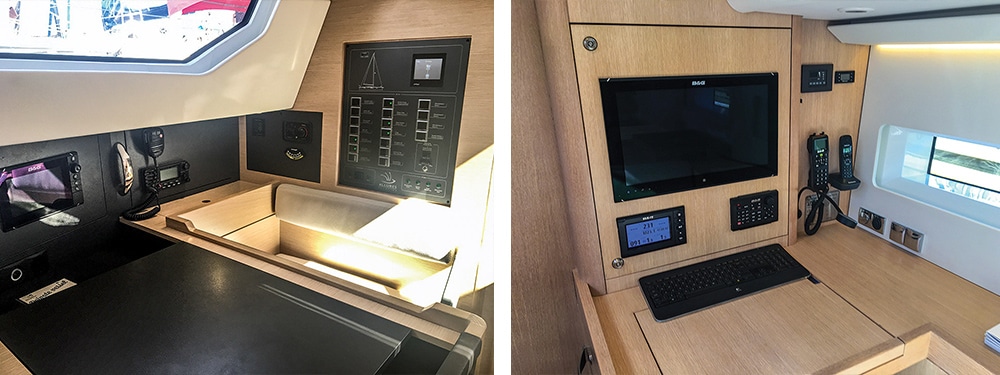
“The Jeanneau 64 comes with a nav station standard, but 90 percent of the buyers don’t want it and opt instead for a Pullman-style berth in its place,” says Jorgensen. “That means that 90 percent will use a PC at the saloon table.”
The trend of forgoing a dedicated nav station was a common one at this year’s Annapolis show, especially on boats of less than 45 feet. “The need is less today than previously,” says Rassy. “We have dropped belowdecks nav stations completely on our 31- and 34-footers.”
Still, not all builders are removing their belowdecks navigation centers. “We believe that nav stations are here to stay on all yachts designed for serious cruising,” says Gunfleet’s Campbell. “Many owners will use the saloon table for preplanning a passage, but prudent owners will still refer to paper charts as a reference at sea. The nav station also tends to be the communications center as well, so it will remain as the place to sit to use a satellite phone or look at the weather, check through emails on a decent-size screen and deal with the multitude of office-type issues involved in running an ocean cruising yacht.”
While many modest-size production boats are forgoing dedicated nav stations, owners are taking advantage of chart plotters with Wi-Fi connectivity to run smart devices and apps that mirror — and in some cases control — their networked plotter. This arrangement saves money (tablets are way less expensive than marine-grade plotters and installed wire runs) and provides workspace flexibility. It’s important, however, to remember that consumer-electronics devices aren’t (typically) waterproof and might not be sunlight readable. A tour of the Annapolis boat show provided a great opportunity to view the many options available for mounting electronics — some good and some that could be improved. Aboard the Beneteau 41.4, Discovery 58 and X-Yachts’ X4, for instance, screen visibility while at the wheel was fine, but depending on your height and where you sit, you might be tempted to reach through the wheel spokes to access the touchscreen (the Elan GT5 also featured a similarly installed plotter, but the boat’s tri-spoke wheel makes reaching through easier and safer). By contrast, the Beneteau 51, Hanse 588, Jeanneau 51, Moody DS54 and Swan 54 all used helm-mounted chart plotters that were fitted onto pods or instrument panels close to the yacht’s centerline, giving users easy access to their displays. Other boats, such as the Allures 45.9, fitted a plotter in a pod that’s physically mounted above the wheel, giving users great screen access but potentially hindering some sight lines.
To my mind, Gunfleet’s Flightdeck pods represented some of the best helm-mounted installation thinking aboard monohulls, but the true show-stunner helm was found aboard HH Catamarans’ magnificent HH66, which features an interior helm station on centerline, as well as a dedicated nav station (complete with a hideaway piano keyboard!) to starboard and a single plotter to port, giving navigators full access to germane information from numerous work and navigation stations. Of course, the HH66’s enviable setup sports an equally memorable price tag, but when it comes to truly ergonomic and user-friendly installations, this high-performance cat is downright impressive.
So, while the challenges — and expectations — of creating terrific installation ergonomics are as hard or harder than ever, the great news is that modern designers and builders enjoy off-the-shelf access to technologies, such as waterproof chart plotters, nav pods and helm-mounted instrument panels, that didn’t exist in 1990 when our Southern Cross was launched. Moreover, wireless devices and Wi-Fi-enabled plotters now give users a huge amount of workspace flexibility. And while serious bluewater sailors will likely always want dedicated nav stations, electronic vector and raster charts — rather than paper ones — will increasingly become the go-to standard, potentially giving designers and builders much more leeway in offering semicustomizable layouts that suit a wide variety of cruising itineraries.








